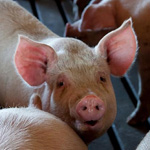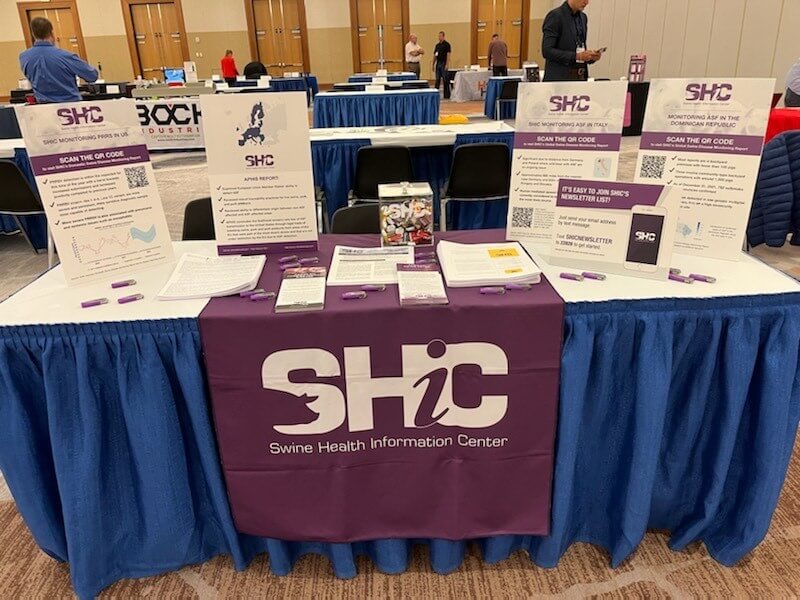
SHIC, launched by the National Pork Board in 2015 solely with Pork Checkoff funding, continues to focus efforts on prevention, preparedness, and response to novel and emerging swine disease for the benefit of US swine health. As a conduit of information and research, SHIC encourages sharing of its publications and research. Forward, reprint, and quote SHIC material freely. SHIC is funded by America’s pork producers to fulfill its mission to protect and enhance the health of the US swine herd. For more information, visit http://www.swinehealth.org or contact Dr. Sundberg at [email protected].

K-State faculty member and researcher expected to begin new duties at SHIC April 1
The Swine Health Information Center (SHIC) is pleased to announce Megan Niederwerder, DVM, PhD, has been chosen for the new role of associate director. Most recently an assistant professor in the Department of Diagnostic Medicine/Pathobiology, College of Veterinary Medicine at Kansas State University, Niederwerder has an expected start date of April 1 with SHIC. “The SHIC mission is consistent with my professional goals of increasing the efficiency of pork production through improving swine health,” Niederwerder commented. “It is an honor to be named the first associate director and I look forward to contributing to the breadth of swine health and disease objectives led by SHIC for the industry.”
In November 2021, the National Pork Board (NPB) Board of Directors provided an additional $15 million to fund the SHIC for another five-year period, through 2027. Subsequent to this extension, the SHIC Board of Directors approved adding the role of associate director for the organization. “The addition of Megan as associate director will help to make SHIC even more impactful and able to meet the needs of pork producers,” remarked SHIC Executive Director Paul Sundberg, DVM, PhD, DACVPM. “We’ll be able to multiply return-on-investment results as SHIC remains faithful to its mission to protect the health of the US swine herd through comprehensive preparedness, monitoring, response, and communications activities.”
Specifically, Niederwerder will assist Sundberg in directing overall expectations and accountability as well as ensuring quality programs and services. This includes collaborating to provide oversight and implementation of the Center’s budget, long range planning, and strategic initiatives. Additionally, Niederwerder will interact closely with the pork community, assisting efforts to build awareness of SHIC, establish and maintain working relationships in the pork industry, and successfully meet the Center’s mission.
“SHIC continues to deliver beyond expectations to the swine industry,” stated Daryl Olsen, DVM, chair of the SHIC Board of Directors. “As the scope of our efforts in prevention, preparedness, and response to emerging and potential foreign swine disease issues grows, so does our need for qualified leadership for the organization. Megan will be an outstanding addition to SHIC with her experience, passion, and knowledge.”
After earning her veterinary degree at Kansas State University, Niederwerder was in clinical practice for three years. Upon her return to Kansas State, she obtained her PhD in infectious diseases of swine, including research projects involving porcine reproductive and respiratory syndrome virus, porcine circovirus type 2, and porcine epidemic diarrhea virus. “My dissertation research as a veterinarian scientist was related to the clinical response of swine to viral diseases,” she explained. “I developed a passion for the health and prevention of disease in swine as well as productivity of the US pork industry.”
During her time as a faculty member in academia, Niederwerder led an internationally renowned research program on viral diseases of swine with focus areas on the risk and mitigation of African swine fever virus introduction through feed and the use of the gut microbiome as an alternative tool for porcine respiratory disease. “I see improvements in swine health to be two-fold, including increasing the health of swine with endemic disease exposure and decreasing the risk of foreign animal disease exposure,” Niederwerder said.
“SHIC is well-positioned to lead the generation of novel swine health data, be the foremost global swine disease news source, and address challenges to swine health with creative solutions for stakeholders,” Niederwerder concluded. “I look forward to advancing the SHIC mission through the role of associate director and working with Paul, the SHIC Board of Directors, and the SHIC Working Groups to serve the needs of US pork producers.”
SHIC, launched by the National Pork Board in 2015 solely with Pork Checkoff funding, continues to focus efforts on prevention, preparedness, and response to novel and emerging swine disease for the benefit of US swine health. As a conduit of information and research, SHIC encourages sharing of its publications and research. Forward, reprint, and quote SHIC material freely. SHIC is funded by America’s pork producers to fulfill its mission to protect and enhance the health of the US swine herd. For more information, visit http://www.swinehealth.org or contact Dr. Sundberg at [email protected].

The Morrison Swine Health Monitoring Project (MSHMP), funded in part by the Swine Health Information Center (SHIC), continues to monitor trends in pathogen incidence and prevalence, including PRRS and the PRRS 1-4-4 L1C variant. MSHMP data analysis looked at the association of manure pumping activities and PRRS outbreaks as well as helped with outbreak investigations by comparing PRRSv sequences. MSHMP is facilitating sharing of health information by tracking multiple diseases, including transport and health relationships, and is growing into adding boar stud and growing pig data to the sow information already gathered.
The 2020-2021 season fortunately ended with the fourth lowest PRRSv breeding herd cumulative incidence (25.8%) during the last 11 years of monitoring. During the most recent year, MSHMP continued to monitor the emergence and dissemination of a new PRRS variant that caused production losses in the Midwest and changed, for the first time, the seasonality pattern historically observed with PRRS, a major epidemic occurring during spring-summer 2020. Exploratory data analysis showed that reporting PRRS outbreaks and manure pumping activities are associated as 40% of the breaks occurred within 30 days of this event regardless of type of manure storage. PEDv continued to be present at a low incidence level as the cumulative incidence remained at 3.5%.
Throughout the year, MSHMP provided outbreak investigation support by comparing PRRSv sequences to the MSHMP database in nine separate occasions as it was requested by six participants. This allowed MSHMP to become a communications facilitator, putting systems in contact whenever both parties agreed as outbreak investigations continued.
Transport data is acquired actively and has been analyzed. Movement data can be obtained at a granular level allowing for traceability but most importantly, allows the producer to follow the truck in real-time. Transport biosecurity compliance continues to become an achievable goal including every single step between the truck-wash, loading of pigs, unloading, and return to truck-wash. Characterization and description of transport data has shown that few transport vehicles come in contact with one-third of the farms of the participating production system, indicating an important level of connectivity. Furthermore, transport characterization highlighted the need to monitor vehicle biosecurity protocols towards disease control as trucks in this system will need to go through the truck wash before returning to a farm. Therefore, truck traceability (e.g. contact tracing) is possible with the current system which aids in complementing outbreak investigations.
MSHMP expansion continues at three levels: sow, boar, and growing pig populations. An approximate total of 42 boar studs from 13 participants have been added to the MSHMP database. The growing pig population continues to grow with seven companies sharing their growing pig locations. Work is being done towards linking sow and growing pig populations in the MSHMP database.

The Swine Health Information Center’s (SHIC’s) domestic disease monitoring reporting system (SDRS) was developed as the result of a veterinary diagnostic lab (VDL) data standardization project utilizing HL7 messaging. SHIC’s support of that work has resulted in a model capturing disease dynamics from daily VDL test results by pathogen over time, specimen, age group, and geographical space. SHIC is now exploring potential expansion of the diagnostic database to increase the breadth of producer disease diagnostic inputs and regional disease surveillance.
The SDRS delivering SHIC’s monthly Domestic Swine Disease Monitoring Reports is operated at Iowa State University. The goal is to aggregate swine diagnostic data from participating reporting VDLs and present it in an intuitive format via shared reports and web dashboards. SHIC is currently discussing participation by other state VDLs using USALIMS (animal laboratory information management system) to seamlessly integrate that information into the SDRS. This work could broaden the monitoring system to add value for SHIC stakeholders who use the data in their work to protect swine herd health.
USALIMS is an off-the-shelf laboratory information management system available for purchase by VDLs. It is fully integrated with its sibling state animal health official companion system, USAHERDS, providing automated interstate veterinary permit laboratory testing results such as horses negative for equine infectious anemia or streamlining issuance of animal movement permits. Seven states currently use both for that purpose. Right now, 18 states use USALIMS to record, report, and bill their veterinary diagnostic laboratory results/information, including animal necropsies submitted to them for diagnostic investigations. USALIMS also provides HL7 messaging for the USDA National Animal Health Network laboratories, providing the basic architecture needed to expand to include the messaging structure used by the SDRS.
Since its creation in 2018, data from four principal swine VDLs, Iowa State University, University of Minnesota, South Dakota State, and Kansas State, have been compiled for analysis and reporting of swine pathogen surveillance as the SHIC monthly domestic disease monitoring report. The Ohio VDL has subsequently joined the SDRS. Currently monitored agents are porcine reproductive and respiratory syndrome virus, porcine circovirus 2, porcine epidemic diarrhea virus, swine influenza A virus, porcine deltacoronavirus, transmissible gastro enteritis virus, and M. hyopnuemoniae. Porcine test results from participating VDLs are organized at the case level by SDRS staff after retrieval. Statistical algorithms are then employed for overall and regional monitoring. An advisory group has been formed to help give context to the data collected and interpret it. Reports are then developed and published.

The Swine Health Information Center participated in the American Association of Swine Veterinarians 53rd Annual Meeting this past weekend in Indianapolis. With a Tech Table at the event, SHIC shared resources and engaged with attendees, discussing emerging disease prevention, preparedness, and response. SHIC publications were often cited by presenters and attendees as essential information sources.


This month’s Domestic Swine Disease Monitoring Report fully brings onboard the Ohio Animal Disease and Diagnostic Laboratory PCR data. There was increased activity of porcine reproductive and respiratory syndrome virus (PRRSV) in some particular regions during February. More intense activity of porcine epidemic diarrhea virus (PEDV) has been detected, with levels of detection being above expected throughout February. The SDRS bonus page brings results of a PRRSV L1C variant virulence study experiment. In the podcast, the SDRS hosts talk with SDRS VDL champions, Drs. Main, Matias-Ferreyra, Prarat, Pillatzki, and Torrison, about their perspective and vision on the major contributions of the SDRS collaborative effort to help swine stakeholders make informed decisions to improve animal health and protect the national food sovereignty.

African Swine Fever (ASF) outbreaks in Haiti and over 900 outbreaks confirmed in the Dominican Republic so far lead to OIRSA and FAO mobilizing resources to support coordination on the island. In Romania, 85 new ASF outbreaks were reported in domestic pigs in February. Their draft ASF surveillance and control action plan is still pending the Romanian government’s approval. A Vietnamese-made commercial vaccine for ASF is expected in the next few months. Pseudorabies Virus (PRV) in France is increasing concern due to spread of the disease in the growing wild pig population. A scientific report included in this month’s Global Swine Disease Monitoring Report details how wild boars are described as a reservoir of a highly virulent clone of hybrid shiga toxigenic and enterotoxigenic Escherichia coli (ETEC) responsible for edema disease.
Copyright 2025 | Swinehealth.org | Website by Heartland Marketing Group